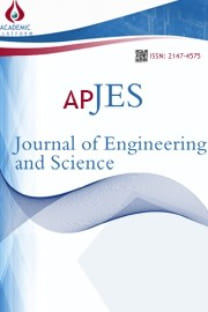Fluidized Electrooxidation Process Using Three-Dimensional Electrode for Decolorization of Reactive Blue 221
___
- [1] W. Tan and B. Khoshnevis, “Integration of process planning and scheduling-a review,” Journal of Intelligent Manufacturing, vol. 11, no. 1, pp. 51–63, 2000, doi: 10.1023/A:1008952024606.
- [2] X. Li, L. Gao, C. Zhang, and X. Shao, “A review on Integrated Process Planning and Scheduling,” International Journal of Manufacturing Research, vol. 5, no. 2, pp. 161- 180, Jan. 2010.
- [3] R. K. Phanden, A. Jain, and R. Verma, “Integration of process planning and scheduling: a state-of-the-art review,” International Journal of Computer Integrated Manufacturing, vol. 24, no. 6, pp. 517–534, 2011.
- [4] N. Morad and A. M. S. Zalzala, “Genetic algorithms in integrated process planning and scheduling,” Journal of Intelligent Manufacturing, vol. 10, no. 2, pp. 169–179, 1999, doi: 10.1023/A:1008976720878.
- [5] W. Tan and B. Khoshnevis, “A linearized polynomial mixed integer programming model for the integration of process planning and scheduling,” J. intell. manuf., vol. 15, no. 5, pp. 593–605, 2004, doi: 10.1023/B:JIMS.0000037710.80847.b6.
- [6] Y. W. Guo, W. D. Li, A. R. Mileham, and G. W. Owen, “Optimisation of integrated process planning and scheduling using a particle swarm optimisation approach,” International Journal of Production Research, vol. 47, no. 14, pp. 3775–3796, 2009, doi: 10.1080/00207540701827905.
- [7] A. Baykasoğlu and L. Özbakır, “A grammatical optimization approach for integrated process planning and scheduling,” Journal of Intelligent Manufacturing, vol. 20, no. 2, pp. 211–221, 2009, doi: 10.1007/s10845-008-0223-0.
- [8] C. W. Leung, T. N. Wong, K.-L. L. Mak, and R. Y. K. Fung, “Integrated process planning and scheduling by an agent-based ant colony optimization,” Computers and Industrial Engineering, vol. 59, no. 1, pp. 166–180, 2010, doi: 10.1016/j.cie.2009.09.003.
- [9] R. R. K. Phanden, A. Jain, and R. Verma, “An approach for integration of process planning and scheduling,” International Journal of Computer ldots, vol. 26, no. 4, pp. 284–302, Apr. 2013, doi: 10.1080/0951192X.2012.684721.
- [10] L. Zhang and T. N. N. Wong, “An object-coding genetic algorithm for integrated process planning and scheduling,” European Journal of Operational Research, vol. 244, no. 2, pp. 434–444, Jul. 2015, doi: 10.1016/j.ejor.2015.01.032.
- [11] T. Hill, Production/operations management: text and cases. Prentice Hall, 1991.
- [12] V. Gordon, J. M. Proth, and C. Chu, “Due date assignment and scheduling: SLK, TWK and other due date assignment models,” Production Planning & Control, vol. 13, no. 2, pp. 117–132, 2002, doi: 10.1080/09537280110069621.
- [13] Y. Yin, S. R. Cheng, T. C. E. E. Cheng, C. C. Wu, and W. H. Wu, “Two-agent single-machine scheduling with assignable due dates,” Applied Mathematics and Computation, vol. 219, no. 4, pp. 1674–1685, 2012, doi: 10.1016/j.amc.2012.08.008.
- [14] Y. Yin, T. C. E. E. Cheng, D. Xu, and C.-C. C. Wu, “Common due date assignment and scheduling with a ratemodifying activity to minimize the due date, earliness, tardiness, holding, and batch delivery cost,” Computers and Industrial Engineering, vol. 63, no. 1, pp. 223–234, 2012, doi: 10.1016/j.cie.2012.02.015.
- [15] Y. Yin, M. Liu, T. C. E. Cheng, C. C. Wu, and S. R. Cheng, “Four single-machine scheduling problems involving due date determination decisions,” Information Sciences, vol. 251, pp. 164–181, 2013, doi: 10.1016/j.ins.2013.06.035.
- [16] M. Iranpoor, S. M. T. T. Fatemi Ghomi, and M. Zandieh, “Due-date assignment and machine scheduling in a low machine-rate situation with stochastic processing times,” Computers and Operations Research, vol. 40, no. 4, pp. 1100–1108, 2013, doi: 10.1016/j.cor.2012.11.013.
- [17] D. L. Yang, C. J. Lai, and S. J. Yang, “Scheduling problems with multiple due windows assignment and controllable processing times on a single machine,” International Journal of Production Economics, vol. 150, pp. 96–103, 2014, doi: 10.1016/j.ijpe.2013.12.021.
- [18] H. I. Demir and H. Taskin, “Integrated Process Planning, Scheduling and Due-Date Assignment,” PhD Thesis, Sakarya University, 2005.
- [19] C. Erden and H. I. Demir, “Integrating process planning, scheduling and due date assignment in a dynamic environment,” PhD Thesis, Sakarya University, 2019.
- [20] H. I. Demir and C. Erden, “Solving process planning and weighted scheduling with WNOPPT weighted due-date assignment problem using some pure and hybrid meta-heuristics,” Sakarya University Journal of Science, vol. 21, no. 2, pp. 210–222, 2017.
- [21] H. I. Demir and C. Erden, “Dynamic integrated process planning, scheduling and due-date assignment using ant colony optimization,” Computers & Industrial Engineering, vol. 149, p. 106799, Nov. 2020, doi: 10.1016/j.cie.2020.106799.
- [22] C. Erden, H. I. Demir, and A. H. Kökçam, “Solving Integrated Process Planning, Dynamic Scheduling, and Due Date Assignment Using Metaheuristic Algorithms,” Mathematical Problems in Engineering, vol. 2019, 2019.
- ISSN: 2147-4575
- Yayın Aralığı: 3
- Başlangıç: 2013
- Yayıncı: Akademik Perspektif Derneği
Halil İbrahim DEMİR, Rakesh Kumar PHANDEN, ABDULLAH HULUSİ KÖKÇAM, BURAK ERKAYMAN, CANER ERDEN
Alparslan Serhat DEMİR, Mine Büşra GELEN MERT, Şeyma ACIR
Hilmi Evren ERDİN, M. Burcu Sılaydın AYDIN, NUR SİNEM PARTİGÖÇ, Hayat Zengin ÇELİK, Arzu PALAZCA, Cigdem HOROZ
Çarpık Dağılımlar için Çarpıklık Düzeltmesi Yöntemine Dayalı X ve R Kontrol Grafikleri
Sevgi YURT ÖNCEL, Handan ÖZARSLAN
Döküm Sanayinde Süreç Tabanlı Temel Gösterimleri ile İstatistiksel Süreç Kontrolü
Esra Ateş GENCELİ, Gülsüm Melike Ürper BAYRAM, Reyhan ŞENGÜR TAŞDEMİR, Türker TÜRKEN, İSMAİL KOYUNCU
Mehmet Zahid YILDIRIM, CANER ÖZCAN, Okan ERSOY
Çoklu Vericili Görünür Işık Haberleşmesinde Kanal
Merve KİMYACI, Selva Muratoğlu ÇÜRÜK
İstanbul Boğazı’nda Transit Geçiş Yapan Gemilerin Egzoz Gazı Emisyonlarının İncelenmesi
